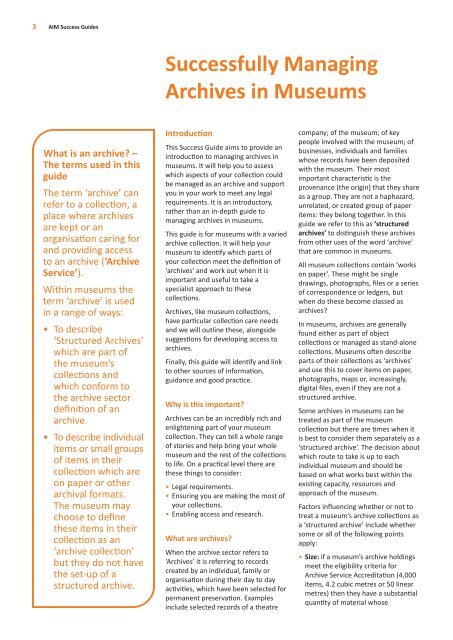Success Guides Successfully Managing Archives in Museums
9bf30cc0-6cd8-11e5-a9ea-901b0e0dc93a
9bf30cc0-6cd8-11e5-a9ea-901b0e0dc93a
Create successful ePaper yourself
Turn your PDF publications into a flip-book with our unique Google optimized e-Paper software.
3 AIM <strong>Success</strong> <strong>Guides</strong><br />
<strong>Success</strong>fully <strong>Manag<strong>in</strong>g</strong><br />
<strong>Archives</strong> <strong>in</strong> <strong>Museums</strong><br />
What is an archive? –<br />
The terms used <strong>in</strong> this<br />
guide<br />
The term ‘archive’ can<br />
refer to a collection, a<br />
place where archives<br />
are kept or an<br />
organisation car<strong>in</strong>g for<br />
and provid<strong>in</strong>g access<br />
to an archive (‘Archive<br />
Service’).<br />
With<strong>in</strong> museums the<br />
term ‘archive’ is used<br />
<strong>in</strong> a range of ways:<br />
• To describe<br />
‘Structured <strong>Archives</strong>’<br />
which are part of<br />
the museum’s<br />
collections and<br />
which conform to<br />
the archive sector<br />
def<strong>in</strong>ition of an<br />
archive.<br />
• To describe <strong>in</strong>dividual<br />
items or small groups<br />
of items <strong>in</strong> their<br />
collection which are<br />
on paper or other<br />
archival formats.<br />
The museum may<br />
choose to def<strong>in</strong>e<br />
these items <strong>in</strong> their<br />
collection as an<br />
‘archive collection’<br />
but they do not have<br />
the set-up of a<br />
structured archive.<br />
Introduction<br />
This <strong>Success</strong> Guide aims to provide an<br />
<strong>in</strong>troduction to manag<strong>in</strong>g archives <strong>in</strong><br />
museums. It will help you to assess<br />
which aspects of your collection could<br />
be managed as an archive and support<br />
you <strong>in</strong> your work to meet any legal<br />
requirements. It is an <strong>in</strong>troductory,<br />
rather than an <strong>in</strong>-depth guide to<br />
manag<strong>in</strong>g archives <strong>in</strong> museums.<br />
This guide is for museums with a varied<br />
archive collection. It will help your<br />
museum to identify which parts of<br />
your collection meet the def<strong>in</strong>ition of<br />
‘archives’ and work out when it is<br />
important and useful to take a<br />
specialist approach to these<br />
collections.<br />
<strong>Archives</strong>, like museum collections,<br />
have particular collection care needs<br />
and we will outl<strong>in</strong>e these, alongside<br />
suggestions for develop<strong>in</strong>g access to<br />
archives.<br />
F<strong>in</strong>ally, this guide will identify and l<strong>in</strong>k<br />
to other sources of <strong>in</strong>formation,<br />
guidance and good practice.<br />
Why is this important?<br />
<strong>Archives</strong> can be an <strong>in</strong>credibly rich and<br />
enlighten<strong>in</strong>g part of your museum<br />
collection. They can tell a whole range<br />
of stories and help br<strong>in</strong>g your whole<br />
museum and the rest of the collections<br />
to life. On a practical level there are<br />
these th<strong>in</strong>gs to consider:<br />
• Legal requirements.<br />
• Ensur<strong>in</strong>g you are mak<strong>in</strong>g the most of<br />
your collections.<br />
• Enabl<strong>in</strong>g access and research.<br />
What are archives?<br />
When the archive sector refers to<br />
‘<strong>Archives</strong>’ it is referr<strong>in</strong>g to records<br />
created by an <strong>in</strong>dividual, family or<br />
organisation dur<strong>in</strong>g their day to day<br />
activities, which have been selected for<br />
permanent preservation. Examples<br />
<strong>in</strong>clude selected records of a theatre<br />
company; of the museum; of key<br />
people <strong>in</strong>volved with the museum; of<br />
bus<strong>in</strong>esses, <strong>in</strong>dividuals and families<br />
whose records have been deposited<br />
with the museum. Their most<br />
important characteristic is the<br />
provenance (the orig<strong>in</strong>) that they share<br />
as a group. They are not a haphazard,<br />
unrelated, or created group of paper<br />
items: they belong together. In this<br />
guide we refer to this as ‘structured<br />
archives’ to dist<strong>in</strong>guish these archives<br />
from other uses of the word ‘archive’<br />
that are common <strong>in</strong> museums.<br />
All museum collections conta<strong>in</strong> ‘works<br />
on paper’. These might be s<strong>in</strong>gle<br />
draw<strong>in</strong>gs, photographs, files or a series<br />
of correspondence or ledgers, but<br />
when do these become classed as<br />
archives?<br />
In museums, archives are generally<br />
found either as part of object<br />
collections or managed as stand-alone<br />
collections. <strong>Museums</strong> often describe<br />
parts of their collections as ‘archives’<br />
and use this to cover items on paper,<br />
photographs, maps or, <strong>in</strong>creas<strong>in</strong>gly,<br />
digital files, even if they are not a<br />
structured archive.<br />
Some archives <strong>in</strong> museums can be<br />
treated as part of the museum<br />
collection but there are times when it<br />
is best to consider them separately as a<br />
‘structured archive’. The decision about<br />
which route to take is up to each<br />
<strong>in</strong>dividual museum and should be<br />
based on what works best with<strong>in</strong> the<br />
exist<strong>in</strong>g capacity, resources and<br />
approach of the museum.<br />
Factors <strong>in</strong>fluenc<strong>in</strong>g whether or not to<br />
treat a museum’s archive collections as<br />
a ‘structured archive’ <strong>in</strong>clude whether<br />
some or all of the follow<strong>in</strong>g po<strong>in</strong>ts<br />
apply:<br />
• Size: if a museum’s archive hold<strong>in</strong>gs<br />
meet the eligibility criteria for<br />
Archive Service Accreditation (4,000<br />
items, 4.2 cubic metres or 50 l<strong>in</strong>ear<br />
metres) then they have a substantial<br />
quantity of material whose


